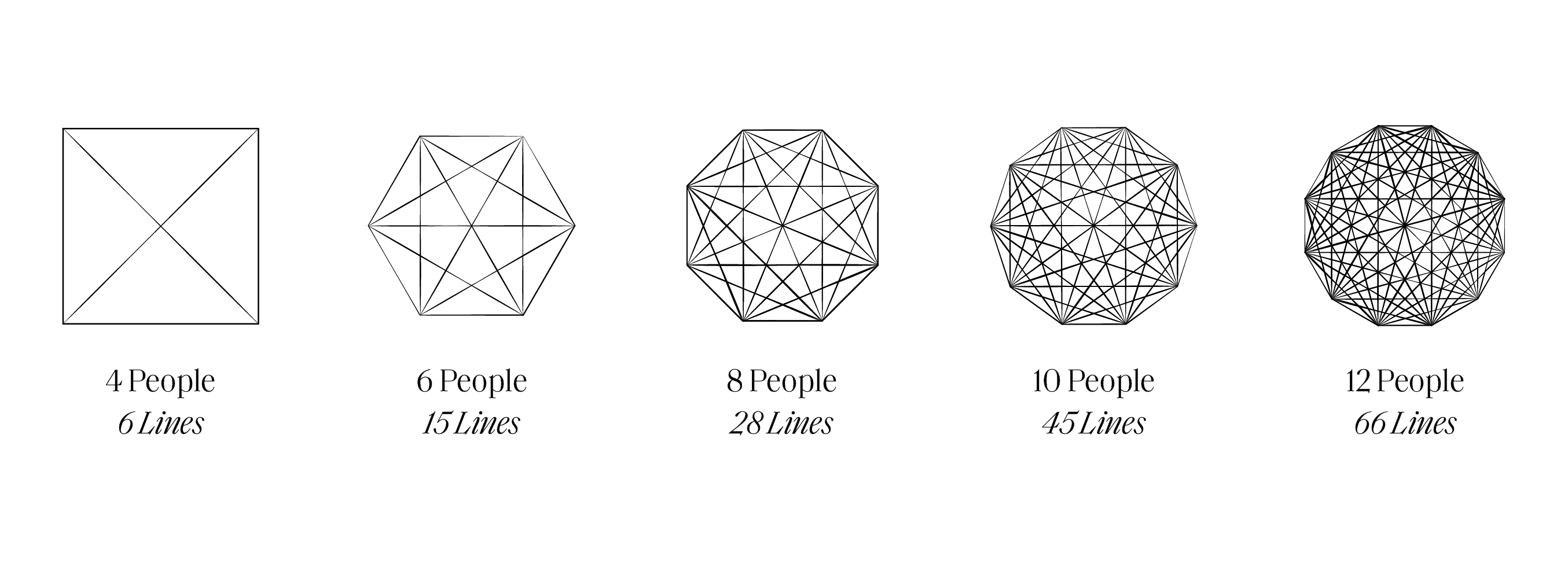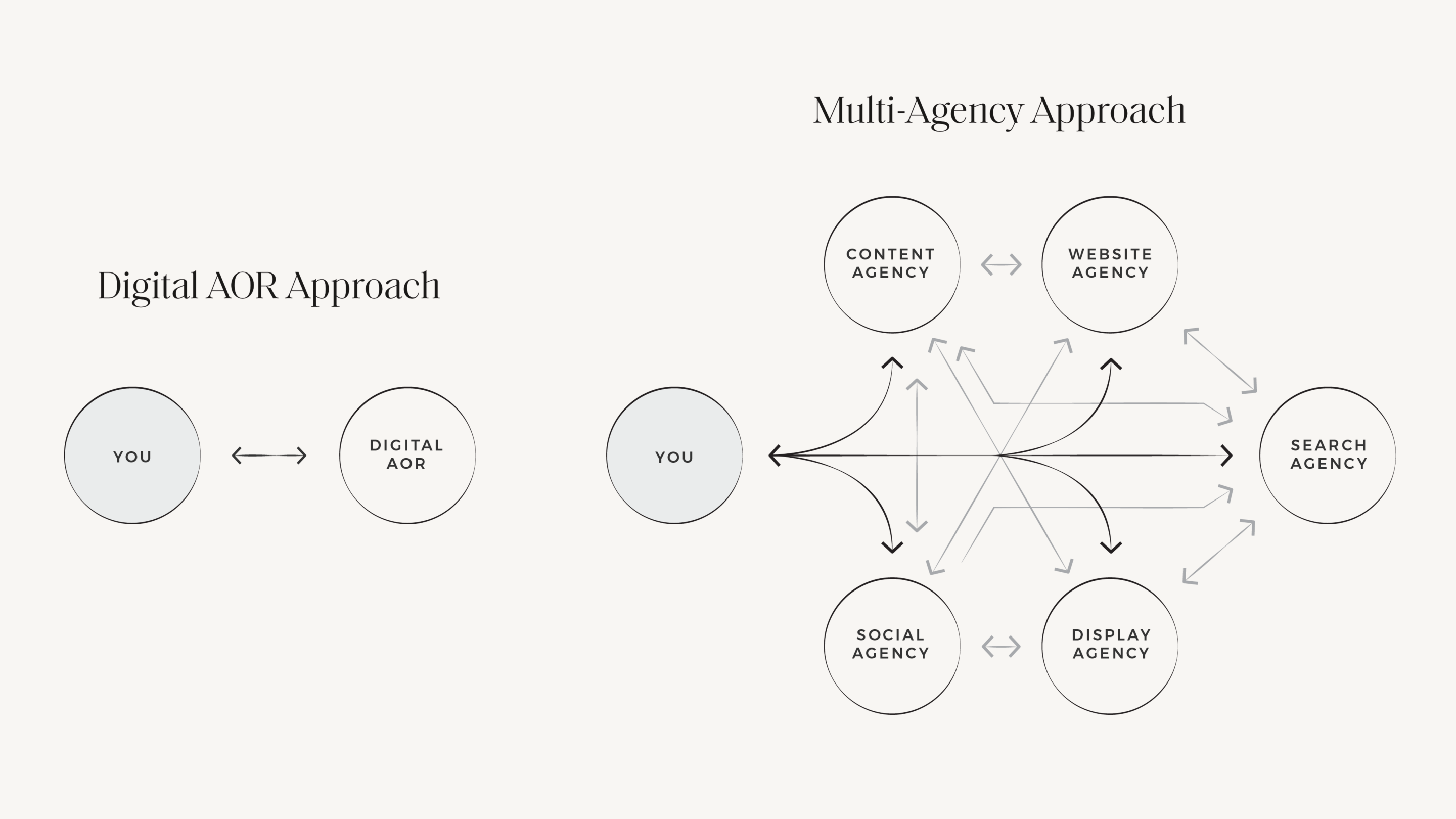WHEN CLIENT MET AGENCY: YOUR GUIDE TO FINDING THE RIGHT MARKETING PARTNER
6. Managing the Agency Relationship
In any relationship, there are going to be ups and downs. But if you and your marketing partner learn how to work together, there will hopefully be more of the former than the latter. Here’s how to build your relationship strong enough to weather any storm—and how to know if it’s irrevocably broken.
Guide To Marketing Agencies
The Hard Parts About Managing a Marketing Partner
In every agency-client relationship, there will obviously be individuals responsible for managing the relationship from both sides. They communicate important information to the necessary team members on each side, and they nurture the working relationship between the two parties.
Sounds great in theory, but when timelines get tight, priorities shift, and feedback gets fuzzy, the relationship can deteriorate quickly. Let’s unpack the hardest parts about working with an agency.
GETTING TIMELINES RIGHT
One of the places where breakdowns between agency and client can happen is timelines. No matter how meticulous and thoughtful the plan is from the get-go, there are almost always speed bumps along the way—stakeholders that need to give approval go on vacation, feedback isn’t consolidated so the review process gets stretched out, next steps are unclear, etc.
When you use an agency to help with your marketing, you’re counting on them to meet deadlines. But that means that you, as the client, also need to hit deadlines for everyone to be successful and for projects to launch on time. Managing the relationship takes time—make sure you’re budgeting enough hours for your internal agency champion.
Another reason timelines get off track is because milestones and deliverables lack clarity. Make sure you and your agency are both on the same page regarding what’s due and when, so that both parties can help move the project along.
One last note—something that tends to extend timelines that people don’t often think about is the review process. It’s okay if you need five people to review a campaign concept, but make sure to consolidate the feedback rather than handing five different sets of edits to your agency and making them figure out what’s what. That way, all feedback is streamlined and you’ll hopefully avoid having to bounce versions back and forth four, five, or six times to get what you want.
COMMUNICATION BREAKDOWNS
Another challenge of working with an agency is that communication, when neglected, breaks down quickly.
Because the agency is likely outside of your office, and because adding an agency is essentially adding more people to your marketing team, small misunderstandings can bubble up into major problems. Communication can be even more challenging if the agency or consultancy is physically located far away. While issues like time changes may not seem like a big deal at first, they can cause friction down the road.
Exponential Nature of Communication

Every company has their own way of communicating. Some like to send tons of emails, others use Slack, and then there are those who prefer old-school communication like phone calls or in-person meetings. To make sure important information doesn’t get lost in the chaos, make sure that you and your agency know which channels should relay which kind of information.
Finally, an agency can’t get you the type of results your business needs if they don’t know what you’re trying to achieve. To the best of your ability, make sure that you’re articulating marketing’s overarching goals so that everyone on both sides understands what you’re trying to achieve.
BUILDING TRUST
As a person tasked with managing a marketing partner, it can be difficult to relinquish some control. It’s understandable, especially when it’s your job, team, and budget on the line. But to get the most from your agency or consultancy, you’re going to need to trust them. More than anything, agencies hate being micromanaged—respect their process and give them space to succeed. Not only will that show you trust your marketing partner, but they’ll in turn trust you more when you do have to shift objectives or get more involved.
Great Relationships Begin and End with Transparency
This is going to sound basic, but the absolute best client-agency relationships are based on transparency and honesty.
Sometimes, it can feel like a game—the agency is dancing around questions about results and the client won’t give clear direction or allow access to specific systems or information. When you play these games, it just causes more confusion and distrust on both sides. If you, as the client, aren’t happy with something, confront the issue with your agency. Allow the agency to do the same without judgement.
The client-agency relationship is all about nurturing open and honest lines of communication that create trust. Without this trust, everything you’ve worked to build can dissolve once results start to slip.
Agencies of Record and Working with Multiple Agencies
When thinking about managing an agency or agencies, it’s helpful to understand how things have changed from the past to the present.
In the past, big brands used to work with a single advertising agency—the Agency of Record (AoR). The AoR would lead brand and advertising strategy for the company, as well as assist in executing the creative vision and buying media. Today, AoRs aren’t bound to traditional advertising alone, but instead include everything from packaging to Facebook ads and more.
The AoR model thrived until something new came along: the internet. The digital age brought different types of agencies—specialized agencies like SEO, web development, and PPC firms. These new types of agencies showcased their value to companies because of their specialized skills and ability to prove ROI and track real impact for businesses quickly.
In other words, the age of the AoR was disrupted.
Now, there’s dispute around whether the AoR is dead or it merely looks different than it used to, but regardless, there are some pros and cons to working with the modern AoR—what we’re calling a lead agency—and working with a variety of specialized agencies—what we call a project-based model.
AoR vs. Multi-Agency Approach

Working with a Number of Specialized Agencies
Recently, there’s been a shift in marketing to bring more decision making and strategy back to the in-house marketers. So, instead of an AoR owning the brand strategy and execution, more businesses are owning the strategy side of things and hiring numerous specialized agencies to execute their vision.
THE PROS
There are some obvious advantages to this kind of approach. First, you’re hiring incredibly specialized talent to execute the work you need done. While full-service agencies and consultancies will also have specialized individuals, you could imagine that an SEO agency that focuses all their energy on SEO will be better at, you know, SEO.
Another pro to this scenario is that the strategy is owned internally. You’re the one making the decisions on what you need, and you can find an agency to bring your vision to life.
THE CONS
As you can see in the chart above, a major con is managing numerous relationships. Not only does this take up a ton of time, but when you’re playing the “lead agency,” you also need those agencies to collaborate with each other to execute your vision. This can cause headaches, especially when agencies might be more concerned about winning more work from your business than necessarily collaborating with each other.
Working with a Lead Agency
When you work with one (for the most part) major marketing partner, you’re following the AoR or “lead agency” model. In this case, you typically use one partner for most of your marketing—everything from digital campaigns to package design and more.
THE PROS
When working with an AoR, you really only manage one relationship as opposed to many when working with a variety of specialized agencies. Another plus is that lead agencies or AoRs typically help with strategy, which means you’re not just hiring a production house or a group of order takers, but people who can help you see your brand and marketing through a different perspective.
THE CONS
An obvious con to working with an AoR is that if your relationship goes south, you’re back to shopping for a new marketing partner—which can be tedious and time consuming. The other con is that, while AoRs have specialists, they’re typically better at seeing the big picture. That means if you need some technical integration help, they might not be as good as an agency that only does that work.
The Breakup: When to Call it Quits
Some things don’t last forever. So when is it time to call it quits and move on?
Let’s look at some averages. According to The Drum, the typical client-agency relationship is about 3.2 years. That said, when assessing the top 40 global brands, the average client-agency relationship was a whopping 22 years.
Because businesses bring in what they need, when they need it, we’re calling this a project-based approach.
22
years
Average length of client-agency relationship for global brands.
The Drum
In the case of global brands, agency relationships are incredibly important, resulting in an enormous amount of trust and growth on both sides. That said, if you’ve tried addressing recurring issues and it’s just not meant to be, you might be forced to break up with your agency. Or they may break up with you. Relationships are two-way streets, after all.
Reasons to Fire Your Agency or Marketing Partner
There are plenty of reasons why you might need to break up with your marketing partner. A few might include:
QUALITY ISSUES
Nothing will ever be truly perfect, but when deliverable after deliverable is underwhelming, you might start to question your partner’s ability to execute.
POOR RESULTS
Whereas quality tends to be more subjective, you can’t argue with the numbers. If your marketing partner is failing to produce real impact for your company, it might be time to have a hard talk.
BAD FIT
Sometimes, the partnership is just a bad culture fit. Ideally, you’d recognize this much earlier (i.e., in the sales process). But when the relationship is toxic and you’ve tried fixing it, it’s probably best to part ways.
LACK OF NEW IDEAS
A major benefit of using an agency is that you get fresh, outside perspective. Once the ideas stop flowing, you might consider finding perspective in new places.
INCONSISTENCY
Missed timelines, patchy communication, knocked-it-out-of-the-park work followed by poor recommendations. Inconsistency can kill a relationship fast.
No one likes to go through the awkward phase of a break up, but you know when it needs to happen. When the results aren’t there, there is no reason to spin your wheels. Holding your agency to the agreed-upon goals and metrics can mean the loss of a client if they aren’t performing. Work with an agency that has a desire to win. In order to be truly successful, an agency must have your best interests in mind.
If you don’t have a mutual level of trust, find another agency. You win together, and you lose together.
A Worthwhile Relationship
Whether you’re looking for a marketing partner, managing the relationship, or considering parting ways, we hope our guide helped you understand the ins and outs to marketing agencies, firms, and consultancies.
If you’re interested in learning more about the work we do, reach out. We’d love to chat!
Start getting better results.
Take your marketing to the the next level. We can help.



